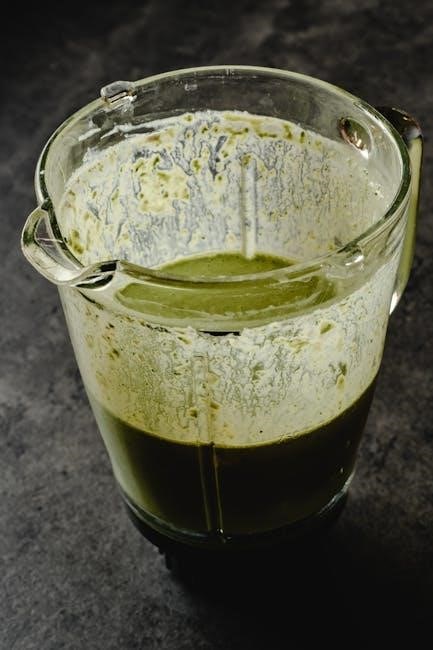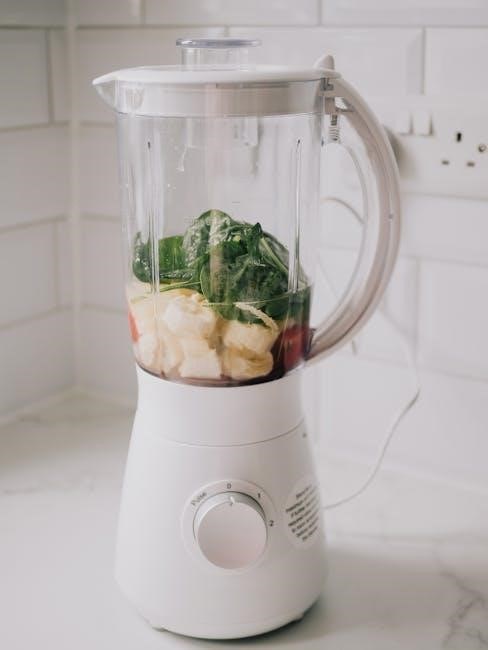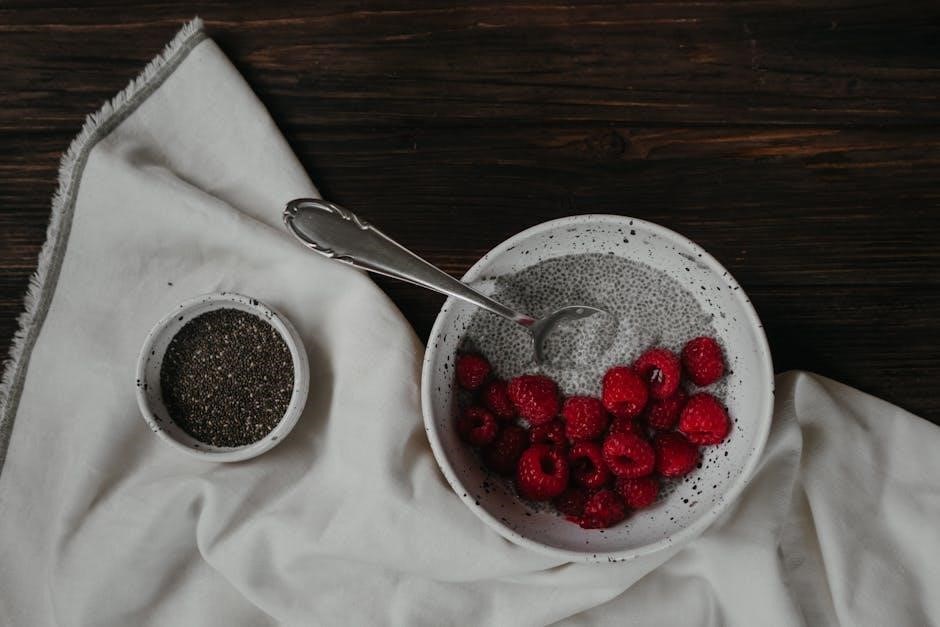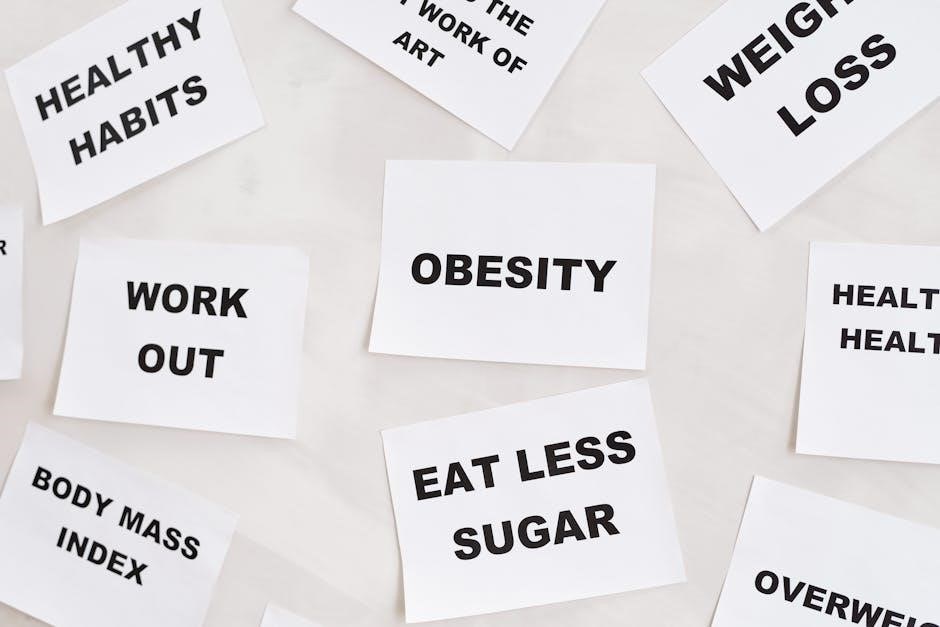Juicing has become a popular method for weight loss, offering a detoxing and metabolism-boosting way to shed pounds. This guide provides expert-approved recipes and a downloadable PDF to kickstart your journey. Discover how juicing can transform your health and support your weight loss goals effectively.
1.1 What is Juicing?
Juicing is the process of extracting liquid from fruits, vegetables, and herbs using a juicer or blender. It separates the juice from the pulp, fibers, and solids, creating a concentrated source of nutrients. Juicing is often used for weight loss due to its ability to provide essential vitamins, minerals, and antioxidants in an easily digestible form. When done correctly, it can help reduce calorie intake while maintaining nutritional value, making it a popular choice for those seeking to shed pounds naturally.
By focusing on low-calorie, high-nutrient ingredients like leafy greens, cucumbers, and citrus fruits, juicing can support weight loss efforts. However, it’s important to balance juices with whole foods to ensure sustained energy and overall health. Juicing is not a standalone solution but rather a complementary approach to a healthy lifestyle.
1.2 Benefits of Juicing for Weight Loss
Juicing offers numerous benefits for weight loss, including detoxification, improved digestion, and enhanced nutrient absorption. It helps reduce calorie intake while providing essential vitamins, minerals, and antioxidants. Juicing can also boost metabolism, suppress appetite, and increase energy levels, making it easier to stick to a weight loss plan. Additionally, it promotes healthy eating habits by incorporating more fruits and vegetables into your diet. Regular juicing can support long-term weight management by fostering a balanced and sustainable lifestyle.
- Supports detoxification and digestion
- Provides concentrated nutrients
- Helps control hunger and cravings
- Boosts metabolism and energy
- Promotes healthy eating habits
1.3 How Juicing Helps in Shedding Extra Pounds
Juicing aids in weight loss by creating a calorie deficit while providing essential nutrients. It replaces high-calorie meals with nutrient-dense juices, reducing overall calorie intake. Juicing also boosts metabolism, helping the body burn fat more efficiently. Additionally, it improves digestion, ensuring better absorption of nutrients. The low glycemic index of vegetable-based juices prevents spikes in blood sugar, promoting steady weight loss. Regular juicing can also reduce hunger and cravings, making it easier to maintain a healthy diet.
- Creates a calorie deficit
- Boosts metabolism
- Improves nutrient absorption
- Reduces hunger and cravings
- Supports balanced blood sugar levels
The Science Behind Juicing for Weight Loss
Juicing enhances nutrient absorption, boosting metabolism and supporting fat loss. It concentrates vitamins, minerals, and antioxidants, providing energy and kickstarting weight loss processes efficiently.
2.1 Understanding the Concept of Juicing Diets
Juicing diets involve consuming nutrient-dense liquids to promote weight loss and detoxification. By extracting juices from fruits and vegetables, these diets focus on improving digestion and absorption of essential vitamins and minerals. Unlike traditional diets, juicing emphasizes liquidity, allowing the body to process nutrients more efficiently. Juicing diets can vary, from short-term cleanses to longer-term meal replacements, but they often prioritize vegetable-based juices over sugary fruit blends to maintain balanced blood sugar levels and support sustainable weight loss. Consulting a professional is advisable to tailor the diet to individual needs.
2.2 Role of Nutrients in Weight Loss

Nutrients play a crucial role in weight loss by supporting metabolism, reducing hunger, and optimizing energy levels. Vitamins like C and A boost metabolism, while minerals such as potassium and iron aid in muscle function and oxygen transport. Fiber enhances digestion, and antioxidants reduce inflammation, which can hinder weight loss. By incorporating balanced nutrients through juicing, the body efficiently burns fat and maintains lean tissue, promoting sustainable weight loss. A focus on nutrient-dense juices ensures the body receives essential components for overall health and effective weight management.
2.3 How Juicing Affects Metabolism
Juicing can positively influence metabolism by providing essential vitamins, minerals, and antioxidants that support cellular function. Fresh juices rich in vitamin C and B vitamins enhance metabolic rate, aiding in fat breakdown and energy production. Antioxidants reduce oxidative stress, which can slow metabolism. Additionally, the digestibility of juices ensures rapid nutrient absorption, boosting metabolic efficiency. A well-balanced juice diet can help maintain a healthy metabolic rate, supporting weight loss efforts and overall bodily function. This makes juicing a valuable tool for metabolism-friendly weight management strategies.

Best Practices for Juicing
Use fresh, organic ingredients, balance fruits and veggies, and drink juices immediately. Dilute if needed and listen to your body for tolerance. Stay consistent but avoid overdoing it.
3.1 Choosing the Right Ingredients
Selecting the right ingredients is key for effective weight loss juicing. Opt for low-calorie, nutrient-dense vegetables like spinach, kale, and cucumbers, which provide volume without excess calories. Incorporate fruits sparingly, as they add natural sweetness but can be high in sugar. Use apples, berries, or citrus fruits for flavor while keeping sugar content in check. Herbs like mint and ginger enhance taste without calories. Always prioritize fresh, organic produce to maximize nutritional benefits and avoid harmful pesticides. Balance your juices to ensure a mix of vitamins, minerals, and fiber for sustained energy and satiety.
3.2 Importance of Vegetable-Based Juices
Vegetable-based juices are essential for weight loss as they are low in calories and rich in nutrients. They provide essential vitamins, minerals, and fiber, which help control hunger and boost metabolism. Unlike fruit juices, vegetable juices are lower in sugar, reducing the risk of energy spikes and crashes. Incorporating leafy greens like spinach and kale ensures a high nutrient intake without excessive calories. This balance supports sustainable weight loss and overall health, making vegetable-based juices a cornerstone of effective juicing diets.
3.3 Tips for Maximizing Weight Loss
To maximize weight loss through juicing, focus on hydration by drinking juices between meals to avoid diluting digestive enzymes. Opt for smaller portions to prevent overconsumption of calories. Balance ingredients by combining vegetables with small amounts of fruit to minimize sugar intake. Incorporate metabolism-boosting ingredients like ginger or cayenne pepper. Pair juices with protein or healthy fats to keep you fuller longer. Stay consistent with your juicing routine and track progress to maintain motivation and achieve lasting results.

Top Juicing Recipes for Weight Loss
This chapter shares delicious, nutrient-rich recipes designed to support weight loss. Discover low-calorie, metabolism-boosting juices packed with vitamins and minerals to help you shed pounds naturally.
4.1 Green Goddess Juice Recipe

This refreshing blend combines spinach, kale, green apple, celery, and lemon for a nutrient-packed drink. Spinach and kale provide iron and vitamins, while green apple adds natural sweetness. Celery contributes hydration, and lemon boosts metabolism. This low-calorie juice supports weight loss by curbing hunger and detoxifying the body. Perfect for mornings, it energizes and kick-starts your metabolism. Simply combine 2 cups spinach, 1 cup kale, 1 green apple, 3 celery stalks, and 1 lemon in a juicer. Enjoy chilled for optimal results.
4.2 Carrot and Ginger Zinger Recipe
This vibrant juice combines carrots, ginger, and apple for a sweet and spicy blend; Carrots are rich in vitamin A and fiber, supporting digestion and satiety. Ginger boosts metabolism and reduces inflammation. The apple adds natural sweetness without excess calories. To make, juice 4 medium carrots, 1-inch ginger, 1 apple, and ½ lemon. Strain if desired and serve fresh. This recipe aids in weight loss by enhancing metabolism and providing essential nutrients while keeping you full longer.
4.3 Cucumber and Mint Refresher Recipe
This refreshing juice is perfect for weight loss, combining cucumber, mint, lime, and green apple. Cucumber is high in water content, aiding hydration and digestion. Mint enhances metabolism and freshens breath, while lime provides vitamin C to boost immunity. The green apple adds a touch of sweetness without excess sugar. To prepare, juice 2 cucumbers, 1/4 cup mint leaves, 1 lime, and 1 green apple. Strain if desired for a smoother texture. This recipe supports weight loss by promoting hydration, metabolism, and satiety.

7-Day Juice Cleanse Plan
This 7-day juice cleanse plan is designed to detoxify, boost metabolism, and support weight loss with nutrient-rich recipes. It helps reset eating habits and enhances well-being.
Start your 7-day juice cleanse with gentle, refreshing recipes to ease your body into the detox process. Focus on simple, nutrient-dense juices like cucumber, celery, and green apple combinations. These days are about acclimating to the cleanse and resetting your taste buds. Incorporate hydrating ingredients and avoid overly sweet juices to stabilize blood sugar. Drink plenty of water and listen to your body’s signals. These initial days set the foundation for a successful cleanse, helping you transition smoothly into more robust recipes.
- Begin with milder flavors to avoid overwhelming your palate.
- Stay hydrated to support detoxification and energy levels.
- Listen to your body and adjust recipes as needed.
Pro tip: Rotate between 3-4 core recipes to keep things interesting and ensure variety in nutrients;
5.2 Day 3-4: Increasing Veggie Intake
On Days 3 and 4, gradually introduce more vegetables to amplify detoxification and nutrient absorption. Incorporate leafy greens like spinach, kale, or collard greens into your juices. These vegetables are rich in fiber, vitamins, and minerals, aiding in metabolism and satiety. Pair them with small amounts of fruit for natural sweetness. Focus on recipes like spinach-apple or carrot-kale juices to maintain flavor while boosting veggie content. This phase helps your body adapt to higher nutrient density and supports weight loss efforts effectively.
- Incorporate leafy greens for enhanced nutrition.
- Balancing flavors with minimal fruit adds satisfaction.
- Monitor progress and adjust recipes as needed.
Pro tip: Rotate between 2-3 veggie-centric recipes to avoid monotony and maximize benefits;
5.3 Day 5-7: Advanced Juice Recipes
By Day 5, transition to more complex, nutrient-dense juices to enhance weight loss. Incorporate ingredients like beets, turmeric, and ginger for their fat-burning and anti-inflammatory properties. Recipes such as the “Root Revival” (beet, carrot, and ginger) or “Golden Elixir” (pineapple, turmeric, and coconut water) can boost metabolism and detoxification. Experiment with herbs like parsley and cilantro to elevate flavors and benefits. This phase focuses on refining your juicing technique and exploring diverse flavors while maintaining calorie deficit and nutrient balance.
- Add metabolism-boosting spices like ginger and turmeric.
- Incorporate root vegetables for sustained energy.
- Experiment with herbs for enhanced flavor and benefits.

Pro tip: Rotate ingredients to avoid plateaus and keep your taste buds engaged.

Tips for a Successful Juice Cleanse
For a successful juice cleanse, plan meals, listen to your body, and stay consistent. Balance flavors, hydrate, and maintain a positive mindset to achieve optimal results.
6.1 Preparing Your Body for Juicing
Preparing your body for juicing involves gradually reducing solid food intake 2-3 days before starting. Focus on fruits, vegetables, lean proteins, and whole grains to ease the transition. Stay hydrated by drinking plenty of water and consider herbal teas. Light exercise can also help detoxify your system. Be mindful of potential detox symptoms like mild headaches or fatigue, which are temporary. Listen to your body and adjust your cleanse as needed for a smoother experience. Start with gentle juices to acclimate your digestive system.
6.2 Managing Hunger and Cravings
Managing hunger and cravings during a juice cleanse requires strategic planning. Start by incorporating small, nutrient-dense snacks like raw vegetables or nuts when needed. Stay hydrated by drinking water or herbal teas between juices. Include protein-rich ingredients like spinach or kale in your juices to keep you fuller longer. Avoid sugary juices that can trigger cravings. Practice mindful eating by sipping slowly and focusing on the flavors. Plan your juices in advance to maintain consistent energy levels and reduce temptation.
6.3 Staying Hydrated
Staying hydrated is essential during a juice cleanse, as it supports digestion and detoxification. Drink water between juices to flush out toxins and maintain energy levels. Include hydrating ingredients like cucumber, celery, and watermelon in your juices. Herbal teas and coconut water can also contribute to hydration. Avoid alcohol and caffeine, which dehydrate the body. Listen to your body and drink when thirsty to ensure optimal hydration. Proper hydration enhances the effectiveness of your juice cleanse and supports overall health.

Common Mistakes to Avoid
Common mistakes include overloading on sugary juices, neglecting nutrient balance, and excessive juicing. These errors can hinder weight loss and cause digestive discomfort or nutrient deficiencies.
7.1 Overloading on Sugary Juices
Overloading on sugary juices can sabotage weight loss efforts. While fruits add natural sweetness, excessive sugar intake can lead to energy crashes and fat storage. Relying too much on high-sugar ingredients like tropical fruits or sweet vegetables can spike calorie consumption. To avoid this, balance juices with low-sugar options like leafy greens, cucumbers, and celery. This ensures you reap the benefits of juicing without the negative effects of excessive sugar, supporting sustainable weight loss and better overall health.
7.2 Not Balancing Nutrients
Not balancing nutrients in your juices can hinder weight loss and overall health. Juicing often lacks protein, healthy fats, and fiber, which are essential for satiety and metabolism. Without these, you may feel unsatisfied and experience nutrient deficiencies. Incorporate ingredients like lean proteins, nuts, or seeds into your juices to ensure a balanced intake. This approach supports sustained energy levels and prevents overeating, making your weight loss journey more effective and healthier in the long run.
7.3 Juicing Too Much
Juicing too much can lead to an imbalanced diet and hinder weight loss efforts. Overconsumption of sugary juices, even from fruits, can spike blood sugar levels and cause insulin resistance. Additionally, excessive juicing may result in a lack of essential proteins and healthy fats, which are crucial for maintaining muscle mass and overall health. It can also lead to digestive issues like bloating and nutrient deficiencies. Moderation is key; ensure your juicing routine complements a balanced diet rather than replacing it entirely. This approach supports sustainable weight loss and long-term well-being.
Juicing can be a powerful tool for weight loss when done correctly. By incorporating healthy recipes and maintaining a balanced diet, you can achieve sustainable results and improve overall well-being. Consistency and patience are key to long-term success. Continue exploring juicing recipes and gradually adopt healthier lifestyle habits to maintain your weight loss journey effectively.
8.1 Maintaining Weight Loss After Juicing
After completing a juicing program, maintaining weight loss requires a balanced diet and regular exercise. Incorporate healthy eating habits, such as portion control and mindful meals. Gradually reintroduce whole foods, focusing on lean proteins, whole grains, and vegetables. Stay hydrated and avoid sugary drinks. Consistency is key; continue juicing as part of a healthy lifestyle but in moderation. Track progress and adjust habits as needed to sustain results long-term. A sustainable approach ensures lasting success without extreme restrictions.
8.2 Incorporating Juicing into Your Lifestyle
Juicing can be a sustainable part of your daily routine, even after weight loss. Start by replacing one meal or snack with a nutrient-rich juice. Balance flavors by combining fruits and vegetables, ensuring variety to avoid boredom. Incorporate seasonal produce to keep juices fresh and exciting. Consistency is key; aim for at least one juice daily. Over time, juicing becomes a healthy habit that supports overall wellness and energy levels, complementing your long-term weight management goals.
8.3 Final Thoughts
Juicing for weight loss can be a transformative journey when done mindfully. By focusing on nutrient-dense recipes and maintaining a balanced approach, you can achieve sustainable results. Remember, juicing is not just about weight loss but also about nourishing your body. Stay consistent, listen to your body, and celebrate small victories. With the right mindset and recipes from your PDF guide, you’ll be well on your way to a healthier, happier you. Embrace the process and enjoy the benefits of a vibrant lifestyle.

Downloadable Juicing for Weight Loss PDF Guide
Unlock your weight loss journey with our expert-crafted juicing recipes, practical tips, and easy-to-follow plans designed to help you achieve your goals.
9.1 What to Expect in the PDF
Discover a comprehensive guide packed with nutritious juicing recipes, detailed meal plans, and expert tips to kickstart your weight loss journey. Learn how to create delicious, healthy juices that support your goals, with step-by-step instructions and ingredient lists. Explore a variety of recipes tailored for different tastes and dietary needs, plus advice on selecting the best fruits and vegetables for weight loss. The PDF also includes tips for maintaining motivation and tracking your progress effectively.
9.2 How to Download the PDF
To access the juicing for weight loss recipes PDF, visit the provided link and click the “Download Now” button. You may need to enter your email address to receive the guide. Once confirmed, the PDF will be sent to your inbox or available for instant download. Save it to your device for easy access and start exploring the recipes and tips right away. The process is quick, secure, and designed to get you started on your juicing journey effortlessly.
9.3 Benefits of Using the PDF Guide
The juicing for weight loss recipes PDF offers a comprehensive guide tailored to your needs. It provides clear, step-by-step instructions and nutritious recipes to help you achieve your weight loss goals. With expert tips and meal plans, the PDF ensures you stay on track while enjoying delicious, healthy juices. It also includes advice on maintaining a balanced diet and tracking your progress. This convenient resource is perfect for those seeking a structured approach to juicing, making it easier to succeed on your weight loss journey.
